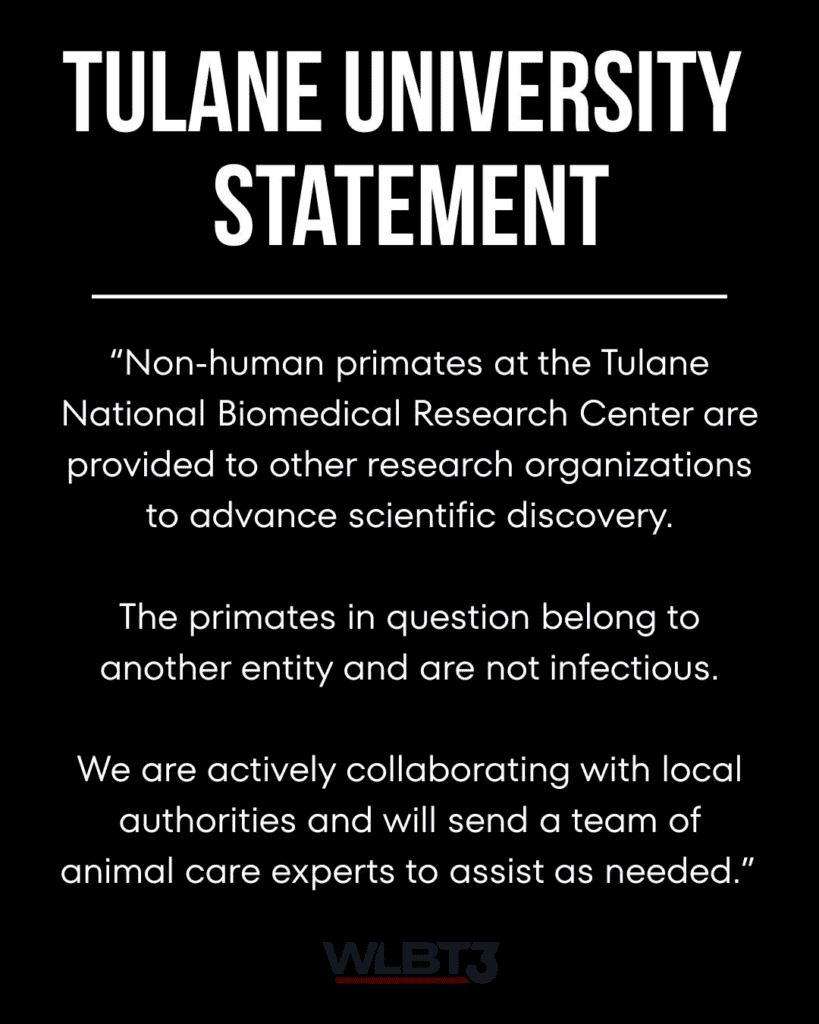What began as a traffic incident on a Mississippi highway quickly turned into a wave of misinformation, fear and public confusion. On October 28, a truck carrying 21 rhesus monkeys overturned on Interstate 56 near Heidelberg. Within hours, false claims about disease-carrying primates and “infected cargo” swept through social media and news outlets, fueled by a Jasper County Sheriff’s Department statement that was based on incorrect information from the truck’s driver, who had told deputies the monkeys were infected with COVID-19, hepatitis C and herpes.

Initial Rumors
The truck was carrying rhesus monkeys, which is a species commonly used in biomedical research. When the vehicle overturned, it scattered crates labeled “live animals” across the median and released several monkeys into the surrounding woods. Initial footage showed the monkeys crawling through the grass as officials from the Jasper County Sheriff’s Department arrived on scene.
In the first moments after the accident, officials on the Jasper County Official Facebook page called the monkeys “aggressive” and claimed they were infected with hepatitis C, herpes, and COVID. These statements came from information given by the driver of the vehicle transporting the animals, who told drivers there was a serious biohazard risk.

Within hours after this statement was made, the claim was proven false. Tulane University, whose National Primate Research Center housed the animals prior to the transport, confirmed the monkeys had not been exposed to any infectious agent. The university also stated the animals did not belong to Tulane, nor were they being transported by the school. Officials later confirmed the driver had been misinformed and no infectious diseases were present.

The New York Times spoke to Sheriff Randy Johnson who first issued the false statement. He regretted the confusion, acknowledging the deputies “reacted to the information they were given at the time.” However, the premature warning had already taken wind on social media and was quickly spreading across all platforms, like Facebook and TikTok. Many posts falsely claimed “lab monkeys with COVID” were loose across Mississippi, prompting panic and speculation about potential quarantine orders.
Escalation and Fallout
In the hours that followed, fear spread faster than facts. Residents began calling law enforcement to report on monkey sightings, many citing worry about the disease transmission. Five monkeys were shot and killed by officials during the initial search, the sheriff’s department said it acted under the impression the animals were “highly infectious.”
As officials worked to correct their previous statements, rumors persisted. Local facebook groups repeated unverified claims that “government scientists” were retrieving infected specimens and that federal agents had arrived to handle a “biohazard” experiment. None of those reports were true. Tulane University reaffirmed that monkeys were health and pathogen free, adding that all remaining animals had been tested before the transport. Mississippi’s Department of Wildlife, Fisheries, and Parks echoed the clarification, stating that while this type of monkey can be aggressive there was no public health risk.
Consequences
Days later, misinformation again proved deadly. On November 3, a Heidelberg resident, Jessica Bond Ferguson, shot one of the escaped monkeys after believing it was dangerous. BBC News reported that Ferguson, a mother of five, said she had been warned that the monkeys “carried diseases” and feared for her children’s safety. “I did what any other mother would do,” she said.
The Jasper County Sheriff’s Department later confirmed the animal was one of the escapees. By then, officials had reiterated multiple times that the monkey was not infectious. Still, the lingering misinformation directly shaped public behavior. This illustrates how even early, retracted statements can catch fire and contribute to the bigger misinformation wave.
The Final Capture
By early November, only one monkey remained unaccounted for. The final animal was captured on November 6 after a local resident in the nearby Vossburg area spotted it and called authorities. The Mississippi Department of Wildlife, Fisheries and Parks confirmed the monkey was safely tranquilized and retrieved.
PreLabs, the biomedical company responsible for the transport, issued a statement confirming the animals were being lawfully moved to a licensed research facility and had not been carrying any unknown diseases. Thirteen monkeys had already reached their intended destination, and no further risks were reported. While the incident itself ended quietly, the misinformation surrounding it did not. Online discussions continued to question Tulane University, research facilities, and federal involvement. Despite public records showing the transport complied with licensing requirements, conspiracy theories flourished, often citing the initial Facebook post and misreported disease warnings as proof of a “cover-up.”
Lessons in Misinformation
The Mississippi monkey escape demonstrates how a single miscommunication can spiral into widespread misinformation when amplified by social media and incomplete official statements. In this case, law enforcement’s early announcement, based on the truck driver’s mistaken account, triggered fear and speculation that persisted long after corrections were made. In the days following the Mississippi highway crash, fear proved more contagious than fact. While officials eventually corrected the record, the damage had already been done: social media panic, needless animal deaths, and one tragic shooting rooted in rumor.
The episode stands as a case study in how misinformation thrives amid confusion, highlighting the responsibility of both public agencies and journalists to verify before warning and the need for audiences to pause before sharing.
References
Associated Press. (October 28, 2025). Monkeys escape from overturned truck on Mississippi highway.
Associated Press. (November 3, 2025). A Mississippi mother kills an escaped monkey fearing for her children’s safety.
Associated Press. (November 6, 2025). The last monkey on the loose after a Mississippi highway crash is captured after being spotted by a resident.
NBC News. (November 7, 2025). The last monkey on the loose after a Mississippi highway crash is captured after being spotted by a resident.
The New York Times. (October 29, 2025). 3 Monkeys Still on the Loose After Truck Overturns on Mississippi Highway.
BBC News. (November 3, 2025). Mississippi mum fatally shoots escaped research monkey.


